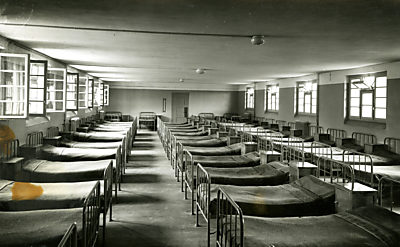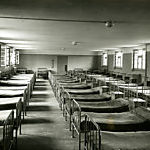A (mass) dormitory in Bellechasse
 Glasson, S.: Schlafsaal der «maison de rééducation au travail» Bellechasse, Sugiez 1948
Glasson, S.: Schlafsaal der «maison de rééducation au travail» Bellechasse, Sugiez 1948 Access to the source
Photographs are an important source of information for documenting alterations of institution buildings or daily life inside them – or for staging the way such things are presented. Photographs can provide us with different impressions at different levels. Pictures «speak» to us as a single whole. They differ from written sources in that the story they tell does not unfold gradually, word by word, but all at once. Everything takes place within a narrow spatial frame and works to convey a message (also) without words. Because of that, analysis of this type of source raises additional considerations in terms of method and approach – as compared to the study of written sources.
As with written documents, however, the first step in determining the historical context is an examination of the circumstances and intentions that lay behind the production of the source, its age and its genuineness. A part of that process, in the case of (historical) photographs is also an investigation into the technical capabilities and procedures that were available at the time they were taken. Today, for example, with a smartphone, it is possible to take sharply-focused pictures – even of moving objects – anywhere. In the early 20th century, by contrast, it was not possible to take a clear portrait of a person unless that person remained motionless before the camera for a few seconds. This explains why the people in pictures from that period often seem unnaturally stiff and serious.
When a single picture cannot stand alone, as in the present example, because it is part of a series, it must be examined within the appropriate context. In our example, the picture of the new dormitory was included in an album prepared for the purpose of documenting the renovation of the building. In other words, the purpose of the album was to provide illustrations of improvements that were made, so that they could be seen by people on the outside. The question of how the pictures were staged – not only in terms of visual language, but also the way they were embedded in texts – thus plays an important role in their historical analysis.
Particularities of the source
In addition to the particularities of this source that have already been mentioned, the investigation of (historical) photographs also comprises a further level. The effect of pictures is more immediate than that of texts. There is an emotional impact to them, which is also fully intentional. Photographs produce their own individual effects. Depending on the temporal context, a person looking at them will understand them in different ways. Individual elements can disappear into the background, giving rise to changing interpretations. The picture of the Bellechasse dormitory shows the image of a (mass) dormitory. As seen from our perspective today, this illustrates the lack of privacy that inmates were subject to during their detention. However, the picture also shows a new that is new, orderly and clean. Cleanliness and orderliness were major topics of discussion at the time the pictures were taken, conditions that were considered worthy of being documented in photographs. This is one example of the kinds of things that might fail to catch our eye the first time we look at such pictures.
L. Seglias/Translation
Source
Glasson, S.: Schlafsaal der «maison de rééducation au travail» Bellechasse, Sugiez 1948.
Signature: Staatsarchiv Freiburg (StAF/AEF): EB Div Photos 13, Bellechasse, Ancienne colonie, 1948, Section V: L’ancienne colonie. La maison de rééducation au travail.
 previous source
previous source
 next source
next source


